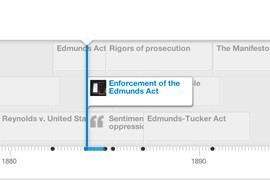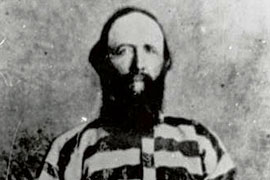Cronkite News has moved to a new home at cronkitenews.azpbs.org. Use this site to search archives from 2011 to May 2015. You can search the new site for current stories.
State historic park in Yuma addresses polygamy in new exhibit
PHOENIX – Among the murderers and other criminals in Yuma Territorial Prison in the mid-1880s, prominent Mormons were also incarcerated.
Their crime? Polygamy.
These otherwise upstanding citizens were imprisoned to serve as an example. Polygamy, common among Mormons at the time, was and continues to be a crime.
An interactive, digital exhibit recounting the stories of nine of these prominent men is now a permanent fixture at Yuma Territorial Prison State Historic Park. It’s based on the scholarship of David Boone, a professor of religious studies at Brigham Young University.
“These men only wanted to live their religion as they believed it should be lived,” Boone said in a telephone interview. “They believed they were doing the right thing by suffering imprisonment.”
Boone, who began his research after finding the prison journal of his great-grandfather, William Jordan Flake, who served six months in the prison, said that these men stood apart from the outlaws with whom they were jailed.
“They were sometimes referred to as ‘prisoners of conscience-sake’ and were never seen, except by the judiciary the courts, as prisoners in the real and literal sense,” Boone said. “The prison warden gave them a lot of freedom to move about and consequently they did a lot of good by way of reform.”
Boone said one prisoner, a former prison warden, worked in the prison kitchen and was able to considerably limit the amount of food being wasted. Another even watched over the prison warden’s two young boys from time to time.
In 1890, the church issued a manifesto that officially banned the practice of polygamy among Mormons. However, the exhibit ties into important social issues that continue today, according to Jason Beduhn, a religious studies professor at Northern Arizona University.
“One of the main issues is that the U.S. Constitution has a religion clause, so with polygamy there is a gray area around social practices and whether they should be protected,” Beduhn said. “In terms of religious diversity, the debate is how do you interpret your own sacred tolerance in society today with what government enforces and does that take precedent over religious liberties? It’s a tricky line to draw.”
The exhibit uses a touchscreen to share the experiences of William Jordan Flake, Jens Neils Skousen, Alma Platt Spillsbury, George Thomas Wilson, Charles Innes Robson, Oscar Marion Stewart, James Thomas Wilson, Hyrum Smith Phelps and Edmund Ellsworth.
“Compared to other exhibits, you feel like there’s a timeline,” said Charles Flynn, executive director of the Yuma Crossing National Heritage Area, which manages Yuma Territorial Prison State Historic Park. “Through different photos and information about each one you get a feel for their lives and from an outsider’s perspective, you understand their religious commitment.”
The exhibit outlines an important piece of Mormon history, according to Wade Noble, a counselor at the Yuma Arizona Stake of The Church of Jesus Christ of Latter-Day Saints.
“We’re kind of proud of our Mormon prisoners,” Noble said. “The practice of polygamy has long been discontinued and the church no longer tolerates it, but we know these men were doing what they believed was right. Their actions after they became prisoners show men of good character, great faith, who went on to success and did a lot of things that showed them to be citizens who contributed to societies.”








